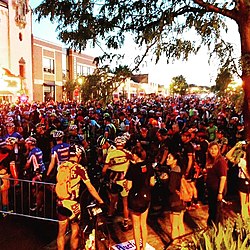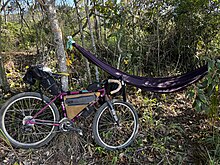
Mountain biking is a sport of riding bicycles off-road, often over rough terrain, usually using specially designed mountain bikes. Mountain bikes share similarities with other bikes but incorporate features designed to enhance durability and performance in rough terrain, such as air or coil-sprung shocks used as suspension, larger and wider wheels and tires, stronger frame materials, and mechanically or hydraulically actuated disc brakes. Mountain biking can generally be broken down into five distinct categories: cross country, trail riding, all mountain, downhill, and freeride.

A racing bicycle, also known as a road bike is a bicycle designed for competitive road cycling, a sport governed by and according to the rules of the Union Cycliste Internationale (UCI).

Cyclo-cross is a form of bicycle racing. Races typically take place in the autumn and winter, and consist of many laps of a short course featuring pavement, wooded trails, grass, steep hills and obstacles requiring the rider to quickly dismount, carry the bike while navigating the obstruction and remount. Races for senior categories are generally between 40 minutes and an hour long, with the distance varying depending on the ground conditions. The sport is strongest in the traditional road cycling countries such as Belgium, France and the Netherlands.

A cyclo-cross bike or cyclo-cross bicycle is a bicycle specifically designed for the rigors of a cyclo-cross race. Cyclo-cross bicycles roughly resemble the racing bicycles used in road racing. The major differences between the two are the frame geometry, and the wider clearances that cyclo-cross bikes have for their larger tires and mud and other debris that they accumulate.
Cycle sport is competitive physical activity using bicycles. There are several categories of bicycle racing including road bicycle racing, cyclo-cross, mountain bike racing, track cycling, BMX, and cycle speedway. Non-racing cycling sports include artistic cycling, cycle polo, freestyle BMX, mountain bike trials and cycleball. The Union Cycliste Internationale (UCI) is the world governing body for cycling and international competitive cycling events. The International Human Powered Vehicle Association is the governing body for human-powered vehicles that imposes far fewer restrictions on their design than does the UCI. The UltraMarathon Cycling Association is the governing body for many ultra-distance cycling races.

Road bicycle racing is the cycle sport discipline of road cycling, held primarily on paved roads. Road racing is the most popular professional form of bicycle racing, in terms of numbers of competitors, events and spectators. The two most common competition formats are mass start events, where riders start simultaneously and race to a set finish point; and time trials, where individual riders or teams race a course alone against the clock. Stage races or "tours" take multiple days, and consist of several mass-start or time-trial stages ridden consecutively.

This is a glossary of terms and jargon used in cycling, mountain biking, and cycle sport.

Mountain bike racing is the competitive cycle sport discipline of mountain biking held on off-road terrain. The Union Cycliste Internationale (UCI) recognised the discipline relatively late in 1990, when it sanctioned the world championships in Durango, Colorado. The first UCI Mountain Bike World Cup series took place in 1988. Its nine-race circuit covered two continents—Europe and North America—and was sponsored by Grundig. Cross-country racing was the only World Cup sport at this time. In 1993, a six-event downhill World Cup was introduced. In 1996, cross-country mountain biking events were added to the Olympic Games. In 2006, cross-country mountain biking events became part of the World Deaf Cycling Championships for the first time in San Francisco, USA.

Katie Compton is an American former bicycle racer. She specialized in cyclo-cross racing and is a 15-time national champion. Compton formerly piloted a tandem with a blind partner in Paralympic events.

The UCI World Championships are annual competitions promoted by the Union Cycliste Internationale (UCI) to determine world champion cyclists. They are held in several different styles of racing, in a different country each year. Championship winners wear a white jersey with coloured bands around the chest for the following year. The similarity to the colours of a rainbow gives them the colloquial name of "the rainbow jersey." The first three individuals or teams in each championship win gold, silver and bronze medals. Former world champions are allowed to wear a trim to their collar and sleeves in the same pattern as the rainbow jersey.
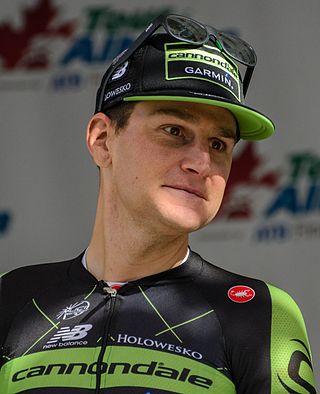
Edward Carrington King is a retired American professional road racing cyclist who last rode for UCI ProTeam Cannondale–Garmin. King turned professional in 2006 and raced for ten years, retiring from contemporary road racing in 2015. He quickly segued to the burgeoning world of gravel cycling, where he has been a pioneer in the world of competitive gravel racing.

Mixed terrain cycle touring is the practice of cycling over a variety of surfaces and topography on a single route, with a single bicycle. The recent popularity of mixed terrain touring is in part a reaction against the increasing specialization of the bike industry.
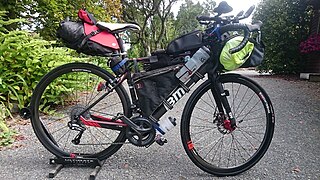
Bikepacking is how a bicycle is packed for bicycle touring. As with backpacking, lightweight packing is a popular topic within bicycle packing. Any kind of bicycle can be used for bikepacking, and specialized touring bicycles often have attachment points from the factory such as low riders and luggage carriers, but most types of bicycles can be equipped with a frame bag, saddle bag, top tube bag and handlebar bag.
The definition of ultra-distance cycling is far more vague than in ultra running or in ultra-triathlon. Any bike race or ride longer than a century ride, which is 100 miles (160 km), is sometimes considered to be ultra-distance cycling. However, such events are relatively common, so using a longer distance to define the category is more useful, such as any race or ride that is longer than 200 kilometres (120 mi), 300 kilometres (190 mi) or even a double century, 200 miles (320 km).

Thomas Pidcock is a British cyclist who currently competes in the cyclo-cross, mountain bike and road bicycle racing disciplines of the sport for UCI WorldTeam Ineos Grenadiers.

Rebecca Rusch is an American endurance professional athlete, seven-time World Champion, author, entrepreneur, Emmy Award winner, and motivational speaker. Rusch's career has spanned adventure sports including rock climbing, adventure racing, whitewater rafting, cross-country skiing and mountain biking.

Unbound Gravel, formerly known as the Dirty Kanza, is an event comprising gravel racing covering various distances held annually during the late spring in the Flint Hills region of the Great Plains around Emporia, Kansas, United States. The race's organizers refer to the 200 miles (320 km) mile race as the "World's Premiere Gravel Grinder", and ranked as one of the top gravel bike races.
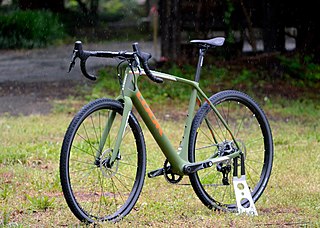
A gravel bicycle is a type of bicycle intended for gravel cycling, including gravel racing. They are also sometimes known as "adventure bicycles", particularly ones intended for harsher off-road terrain.
Tessa Neefjes is a Dutch racing cyclist, who currently rides for Giant Liv Benelux Offroad Team. She's the 2022 European Champion Mountain bike Beach race and the 2022 Dutch Champion Mountain bike Marathon. In 2022 she won two UCI Gravel World Series races in Millau and Houffalize and the Dutch Gravel Series.
